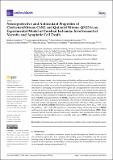Por favor, use este identificador para citar o enlazar a este item:
http://hdl.handle.net/10261/330407COMPARTIR / EXPORTAR:
 SHARE SHARE
 CORE
BASE CORE
BASE
|
|
| Visualizar otros formatos: MARC | Dublin Core | RDF | ORE | MODS | METS | DIDL | DATACITE | |

| Título: | Neuroprotective and Antioxidant Properties of CholesteroNitrone ChN2 and QuinolylNitrone QN23 in an Experimental Model of Cerebral Ischemia: Involvement of Necrotic and Apoptotic Cell Death |
Autor: | Chamorro, Beatriz; Izquierdo-Bermejo, Sara; Martín de Saavedra, María Dolores; López-Muñoz, Francisco; Chioua, Mourad CSIC ORCID ; Marco-Contelles, José CSIC ORCID; Oset-Gasque, María Jesús | Palabras clave: | Cerebral ischemia Neuroprotection Nitrones Oxidative stress Stroke Therapeutic agents |
Fecha de publicación: | jul-2023 | Editor: | Multidisciplinary Digital Publishing Institute | Citación: | Antioxidants 12(7): 1364 (2023) | Resumen: | Ischemic stroke is the leading cause of disability and the second leading cause of death worldwide. However, current therapeutic strategies are scarce and of limited efficacy. The abundance of information available on the molecular pathophysiology of ischemic stroke has sparked considerable interest in developing new neuroprotective agents that can target different events of the ischemic cascade and may be used in combination with existing treatments. In this regard, nitrones represent a very promising alternative due to their renowned antioxidant and anti-inflammatory effects. In this study, we aimed to further investigate the neuroprotective effects of two nitrones, cholesteronitrone 2 (ChN2) and quinolylnitrone 23 (QN23), which have previously shown great potential for the treatment of stroke. Using an experimental in vitro model of cerebral ischemia, we compared their anti-necrotic, anti-apoptotic, and antioxidant properties with those of three reference compounds. Both ChN2 and QN23 demonstrated significant neuroprotective effects (EC50 = 0.66 ± 0.23 μM and EC50 = 2.13 ± 0.47 μM, respectively) comparable to those of homo-bis-nitrone 6 (HBN6) and N-acetylcysteine (NAC) and superior to those of α-phenyl-N-tert-butylnitrone (PBN). While primarily derived from the nitrones’ anti-necrotic capacities, their anti-apoptotic effects at high concentrations and antioxidant powers—especially in the case of QN23—also contribute to their neuroprotective effects. | Versión del editor: | https://doi.org/10.3390/antiox12071364 | URI: | http://hdl.handle.net/10261/330407 | DOI: | 10.3390/antiox12071364 2076-3921 |
| Aparece en las colecciones: | (IQOG) Artículos |
Ficheros en este ítem:
| Fichero | Descripción | Tamaño | Formato | |
|---|---|---|---|---|
| antioxidants-12-01364-v2.pdf | 4,56 MB | Adobe PDF |  Visualizar/Abrir |
CORE Recommender
SCOPUSTM
Citations
1
checked on 17-abr-2024
WEB OF SCIENCETM
Citations
1
checked on 26-feb-2024
Page view(s)
37
checked on 30-abr-2024
Download(s)
25
checked on 30-abr-2024
Google ScholarTM
Check
Altmetric
Altmetric
Este item está licenciado bajo una Licencia Creative Commons

